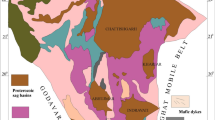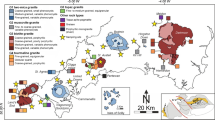Abstract
Recognized in the Xianghualing region, South Hunan are three major types of granitoids. i.e., biotite granite, zinnwaldite-albite granite and xianghuagite, which evolved from the same granitic magma, but were formed at different stages. These granitoid rocks constitute a complete magmatic evolutionary series.
With the evolution of magma, REE contents and negative Eu anomalies tend to decrease progressively, and LREE become more and more enriched relative to HREE. The facts mentioned above show that the tendency of REE evolution in granitoid rocks in the region studied is different from that in other regions.
Evidence indicates that the granitic magma system became more and more depleted in Si(K+Na), but richer and richer in Al, Li, F and H2O+ during the process of its evolution, resulting in relatively weak acidity and strong alkalinity. It may be the most important factor leading to a specific REE evolutionary trend for the granitoid rocks in this region. In addition, the changing oxidation-reduction environments at different evolutionary stages of this magma system may be another important factor which should be taken into consideration.
Similar content being viewed by others
References
Du Shaohua and Huang Yunhui (1984) Studies of xianghuagjte.Scientia Sinica, Series B.28 (5). 537–548 (in Chinese).
Guo Chengji (1985) REE Geochemical Evolution (Volume 1). People’s Publishing House of Guizhou Province, Guiyang,433–437 (in Chinese).
Institute of Geochemistry, Academia Sinica (1979) Geochemistry of Granitoid Rocks in South China. Science Press, Beijing, 289–300 (in Chinese).
Kosals, Ya. A. (1981) The Major REE Geochemical Characteristics of Granitoid Melts and Solutions. Geology Press. Beijing (Chinese version).
Kovalenko, N.I. (1977) Interaction of granite with hydrofluoric acid solutions in connection with the study of the genesis of F-bearing granites.Geokhimia. (2) (in Russian).
Kovalenko, N.I. et al. (1977) Fluorine distribution between Ongonite melt and a coexisting fluid. Geokhimia,(4), (in Russian).
Lagowski, J.J. (1983) Modern Inorganic Chemistry (the lower volume). Senior Education Publishing House, Beijing (Chinese version), p. 505.
Li Tong and Rao Jilong, 1963. Average chemical composition of magmatic rocks in China.Acta Geobgica Sinica,43 (3), 271–280 (in Chinese).
Author information
Authors and Affiliations
Rights and permissions
About this article
Cite this article
Shaohua, D., Ruizhao, Q. A preliminary study on the evolutionary characteristics of rare earth elements (REE) in granitoid rocks and their formation mechanisms in Xianghualing region, Hunan Province, China. Chin. J. of Geochem. 10, 68–79 (1991). https://doi.org/10.1007/BF02843299
Issue Date:
DOI: https://doi.org/10.1007/BF02843299




